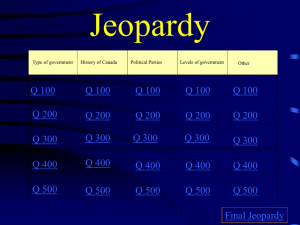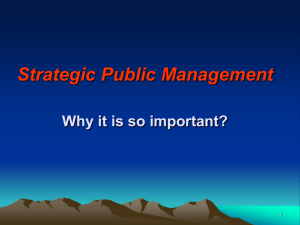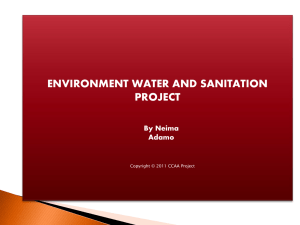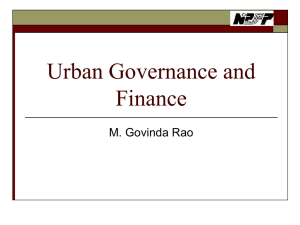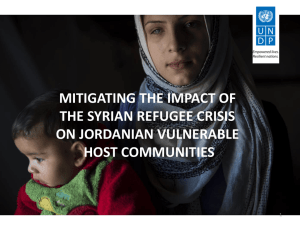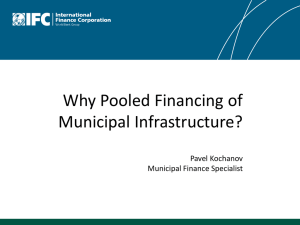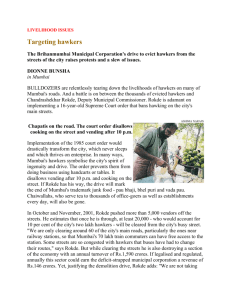Highlights of State of Municipal Education in Mumbai
advertisement
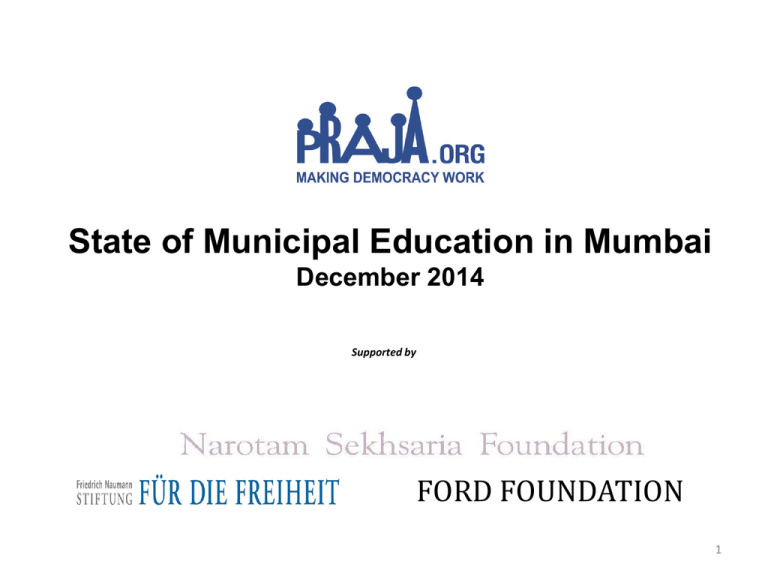
State of Municipal Education in Mumbai December 2014 Supported by FORD FOUNDATION 1 Data from RTI 2 Retention Rate in Municipal Schools Class 1 to Class 7 Standard 1 2 3 4 5 6 7 Academic Year 2009-10 2010-11 2011-12 2012-13 2013-14 2014-15* 2015-16* Total Enrolments 67,477 61,071 59,691 59,160 53,056 47,653 42,901 Retention Rate (%) Year on Year 90.5 88.5 87.7 78.6 70.6 63.6 Only 63.6% of students who enrolled in Class I in 2009-10 are likely to make it to Class 7 in 2015-16. * Estimated using time-series regression. 3 Percentage Change in Class I Enrolments 2009-10 to 2013-14 Year 2009-10 2010-11 2011-12 2012-13 2013-14 2014-15* 2015-16* 2016-17* No. of students enrolled in Class I 67,477 62,587 53,729 46,913 39,663 33,169 27,753 23,072 % Change Year on Year 6.4% -7.2% -14.2% -12.7% -15.5% -16.4% -16.3% -16.9% • In the last five years, Class I enrolments have gone down by 41%. • At this rate, only 23,072 students may enrol in Class I in 2016-17. • If 100 students enrolled in Class I in 2009-10, in comparison only 59 students enrolled in Class I in 2013-14. *Estimated using time-series regression. 4 Total Students in Mumbai’s Municipal Schools 2009 - 2014 Year 2009-2010 2010-2011 2011-2012 2012-2013 2013-14 Total Students 455,900 437,863 439,153 434,523 404,251 % Change in Enrolments Year on Year 0.9% -4% 0.3% -1.1% -7% Medium-wise Change in Enrolments Year on Year Marathi -4.6% -8.1% -6.9% -11.2% -10.8% Hindi 5.8% -1.4% 3% 0.7% -8.9% English 37.1% 1.2% 22.2% 18.1% 1.2% Urdu -2.9% 2.6% 2.1% 0.5% -3.3% Gujarati -7.4% -7.5% -10.4% -12.9% -19.2% Kannada -8.2% -6.4% -8.1% -9.2% -21.5% Tamil 2.7% -17% -12.3% -3.2% -10.6% Telugu -12.1% -15.6% 0.2% -8.8% -23.4% • 51,649 students have left municipal school system in five years (11.3%). • Barring English, enrolments across all other mediums of instruction have declined in 2013-14. 5 Dropouts* in Mumbai’s Municipal Schools 2009 - 2014 Year 2009-2010 2010-2011 2011-2012 2012-2013 2013-14 Dropouts 29,468 18,700 32,580 40,011 47,218 Dropouts (per 100) 6 4 7 9 12 Medium-wise Dropouts Year on Year Marathi 4.5% 2.4% 5.6% 6.7% 7.4% Hindi 9.6% 6.3% 9.7% 14.1% 17% English 6.1% 4.1% 5.4% 4.8% 5.8% Urdu 6% 4.6% 7.8% 8.5% 13.1% Gujarati 4% 1.9% 4.6% 5.4% 4.5% Kannada 5.2% 3% 6.2% 8.1% 10.5% Tamil 4.1% 2.3% 3.8% 4.4% 6.6% Telugu 8.5% 4.7% 12.1% 11.2% 9.7% • 12 out of 100 students dropped out in 2013-14, compared to nine out of 100 students in 2012-13. • Dropout rates for Hindi and Urdu mediums have increased significantly in the last five years. *Dropouts indicate students who enrolled in the academic year but did not complete it. 6 Compliance with Infrastructure and other norms under RTE Indicator : Schools with Infrastructure Facilities Available Govt. and Local bodies Pvt. Aided Pvt. Unaided Total Schools 1266 1266 100.00 1212 95.73 1006 79.46 1125 88.86 1261 99.61 1264 99.84 1266 100.00 1071 84.60 1221 96.45 1183 93.44 443 443 100.00 416 93.91 265 59.82 394 88.94 426 96.16 433 97.74 443 100.00 383 86.46 394 88.94 386 87.13 653 653 100.00 620 94.95 295 45.18 503 77.03 614 94.03 635 97.24 653 100.00 615 94.18 593 90.81 538 82.39 Building Office cum store cum HM room One class room for every teacher Ramp Separate Toilet for Boys Separate Toilet for Girls Drinking Water Facility Kitchen Shed (Govt. &Aided Schools) Boundary Wall Playground Number % Number % Number % Number % Number % Number % Number % Number % Number % Number % Un-recognised 110 110 100.00 105 95.45 78 70.91 44 40.00 108 98.18 107 97.27 110 100.00 106 96.36 81 73.64 79 71.82 7 Teacher Inspection Reports Particulars of Inspection Form Dropout (Per 100) 2012-13 Pass out (In %) 2012-13 No. Of Teachers No. Of Teachers whose inspection reports provided % L G/N P/South 14.1% 45% 896 368 41% 9.3% 50% 623 369 59% 12.2% 58% 430 119 28% Usage of examples, case study while teaching Teaching Aids Use Student Involvement Usage Yes Good 98% 87% 73% 86% 79% 66% 100% 94% 82% Formative Evaluation Technique Used Yes 96% 83% 100% Teacher Student Interaction Proper 76% 63% 87% Entries in the daily lesson plan and actual teaching Complete 96% 84% 97% Self evaluation by the teacher Good 53% 9% 50% Prepared test papered or question paper Teacher’s Portfolio Subject wise student’s response Prepared Good Good 91% 55% 56% 85% 48% 45% 94% 66% 66% 8 Continuous and Comprehensive Evaluation (CCE) Continuous and Comprehensive Evaluation (CCE) refers to a system of school-based assessment of students that covers all aspects of students' development introduced under Right to Education Act. 4th Standard (No. of students in %) Wards G/N, L, P/S, C, D, T 7th Standard (No. of students in %) Above 60% (A1, A2, B1, B2 grades) 60% to 40% (C1, C2 grades) Less than 40% (D, E1, grade) E2 (continu ously absent) Above 60% (A1, A2, B1, B2 grades) 60% to 40% (C1, C2 grade) Less than 40% (D, E1, grade) E2 (contin uously absent) 62% 16% 2% 20% 69% 20% 1% 10% E2 grade is given by MCGM to students who are continuously absent i.e. dropouts as earlier maintained. Note: Above data has been compiled from two datasets, data on CCE reports and continuous absent students. 9 Comparison between Students of MCGM and Other Schools Indicators MCGM Other Schools* SSC Passout 67% 83% Middle School Scholarship (Std. 4th) 1.3% 9.4% High School Scholarship (Std. 7th) 0.1% 8.1% *Other Schools- Private aided, Private Unaided and Unrecognised Schools 10 Annual Municipal Budgets 2009-2015 Year Total Annual Budget (In Rs.Crore) Total Students 2009-10 2010-11 2011-12 2012-13 2013-14 2014-15 1,255 1,761 1,800 2,388 2,534 2,870 449,179 437,911 439,108 434,523 404,251 404,251 Between 2009-10 and 2014-15, MCGM budget for Education has more than doubled. 11 Per-child allocation (In Rs.Crore) Account Head Total Education Budget (Primary and Secondary) Less: Grants to Private Primary aided School (D) Total Total students (2013-2014) Per Child Allocation (in rupees) Budget Estimates 2013-14 Actual Budget expenditure Estimates 2013-2014 2014-15 2,534 1,540 2,870 283 242 415 2,251 1,298 2,455 404,251 404,251 404,251 55,676 32,118 60,729 Per-child Allocation under the Municipal Budget has increased to Rs.60,729, as per Budget Estimates 2014-15. 12 Data from Household Survey Praja Foundation had commissioned a household survey to Hansa Research. The survey was conducted in March-April 2014 across the city of Mumbai with a total sample size of 22,580 households. Of these, 4,276 households had children going to school. Hence, the education questionnaire was administered further with those (4,276) households only. 13 Reasons for not being happy with Municipal School (%) Quality of education, teachers and infrastructure form the three big reasons cited by parents for not being happy with municipal schools. 14 Respondent taking private tuitions/coaching classes: Yes No All Private School Municipal School 66% 34% 71% 29% 42% 58% 42% students from Municipal Schools take private tuitions / coaching classes Details on source of Tuitions: School Class teacher Private tuitions Coaching classes Others All Private School Municipal School 12% 80% 7% 1% 13% 79% 7% 1% 9% 83% 5% 3% 9% students from Municipal schools take tuitions from their own school class teachers. 15 Deliberation by Councillors on Education in the year April’13 to March’14 • 133 questions were asked on issues related to Education in 2013-14, as compared to 134 questions in the previous year. • 55 questions were asked by Education Committee members in 201314, as compared to 66 questions in 2012-13. • 157 (of 227) councillors have not asked a single question on Education this year. • 43 councillors have asked only one question on education. • Only six councillors have asked more than four questions. • Only four questions have been asked on Drop out rates. 16 What Needs to be Done More transparency and accountability in Education Department. Appoint independent, third party, to monitor and evaluate learning outcomes of students. Empower and Strengthen School Management Committees (SMCs) to improve accountability at the school level. Focus on teacher trainings, SMC trainings and capacity building; free teachers from unnecessary administrative duties Rigorous filling out of Continuous Comprehensive Evaluation (CCE) reports and Inspection reports. Link reports with performance appraisal of respective teachers. Strengthen Data management systems especially the Research Officer’s wing, for better planning and implementation. Providing quality education is the duty of the Corporation. Quality of education should be the only paramount focus of the Corporation. 17 THANK YOU. 18
